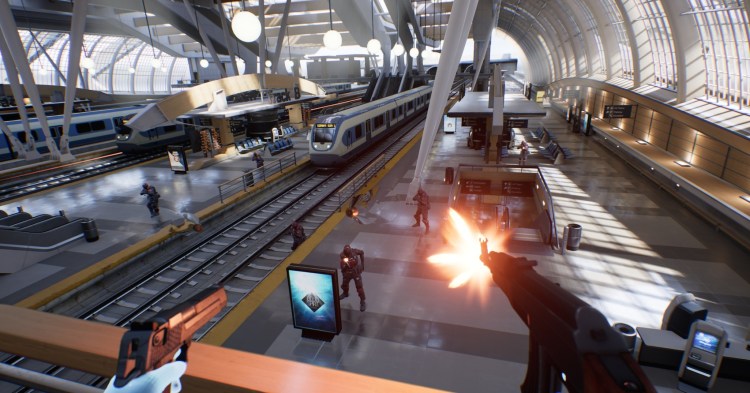Sweeney: Disruptive, but also empowering. The nice thing about involvement in this wave of the future — imagine your ugly sunglasses with a 4K display for each eye. Over time the hardware will be cost-reduced to the point where if you live in Africa and all you have access to is a cell tower and a power source to charge your device—With a $100 device you could have a far better entertainment experience than anybody can buy for any price right now.
That’s maybe 15 years out. But we’re about to see some big changes. It’s going to move away from this weird state the industry has been in the last few years with the mobile revolution. We went from super high-end games dominating the market to very simple ones. You have to realize that phenomenon arose because we have these ubiquitous devices with really tiny screens that only allow for a very limited game experience. After years of experimentation we found these awesome ways of monetizing 2D games that don’t have a lot of depth.
Once you go back to a fully immersive, better than console experience, it’s going to bring hardcore, super high fidelity gaming back to several billion new gamers to this audience that’s grown over the last few years. It’s going to be revolutionary for the whole industry.
GamesBeat: You said you saw Magic Leap under NDA and they were doing things you didn’t think were possible. Can you narrow that down a little bit?
Sweeney: Who’s heard about the Xerox PARC laboratory from the ‘60s and ‘70s? It was before my time. But I feel like what I saw there, it was like an extension. I hadn’t thought some of that stuff was possible, but they were doing it right there. They had the devices in their lap. They were making it work. It felt like if you teleported back to 1972 and saw the first mouse, the first graphical user interface, the future of computing right there.
This is probably happening in a lot of other places besides Magic Leap that I haven’t seen. But that’s part of the revolution that’s happening right now.
Question: You mentioned editing and altering VR. Can you expand more on what you’re trying and thinking about in that area for developers?
Sweeney: We’re all building VR content. It’s pretty ridiculous that we’re using 2D monitors and mice to do it. It’ll take something that interprets gestures to do this, but you’ll be able to reach out with your motion controllers, one in each hand, and directly manipulate the environment.
I imagine it’ll work a lot like manipulating your iPhone. One button on each controller moves the world. You can pan the world around you and pinch the view, so you can zoom way out and then view it like you’re Godzilla from far above. You could zoom way down to human scale and paint fine detail on lawns. You’d have geography editing, painting with colors, all the techniques that you use now in a combination of Photoshop and 3D Studio Max for modeling. You’d use this with a motion controller and a bunch of buttons that bring up different tools.
As you’re in that VR environment, you’d need to be able to pull up and interact with traditional user interface outlets, which for now are a Windows-like user interface. The goal, when this has come to full fruition, is to be able to do live editing of full VR scenes from all directions without ever leaving the VR environment, including switching over and writing some code or drawing some shader notes in an individual shader system. We’ll be able to bring that all together into a cohesive VR experience.
While it’s not related to the 3D aspects of VR, there’s a lot of basic research to do in user interfaces. We’re doing a lot of experimentation to make that work. I think that’s going to come a lot sooner than later in a basic, usable form.
GamesBeat: Sounds like Tony Stark designing the Iron Man suit in the movies.
Sweeney: We’re very close to that time.
Question: Do you think, because of VR, there’s going to be any particular category of games that will utilize it especially well and capture a lot more market share?
Sweeney: Some of the first smartphone games were ports of shooters, and they didn’t work very well. The touch screen wasn’t any substitute for a joystick. We’re going to see the same thing with VR. You can’t run around at 30 miles an hour and turn on a dime without barfing pretty quickly. So we’ll have to see. We’ve experimented with a visceral shooter experience in the Bullet Time demo. It also looks very promising for tabletop games, where instead of being immersed in an environment, you have an awesome gaming set in front of you that you can reach out and manipulate, scaling up and scaling down, pinch to zoom, using a controller to interact with it.
The great thing about VR is that the input is going to be so drastically better than mouse input or games with touch controls on smartphones. It’ll make it much easier to build stuff and express yourself freely. That’s going to reach a much higher level of importance than on past gaming platforms.
VentureBeat's mission is to be a digital town square for technical decision-makers to gain knowledge about transformative enterprise technology and transact. Learn More



